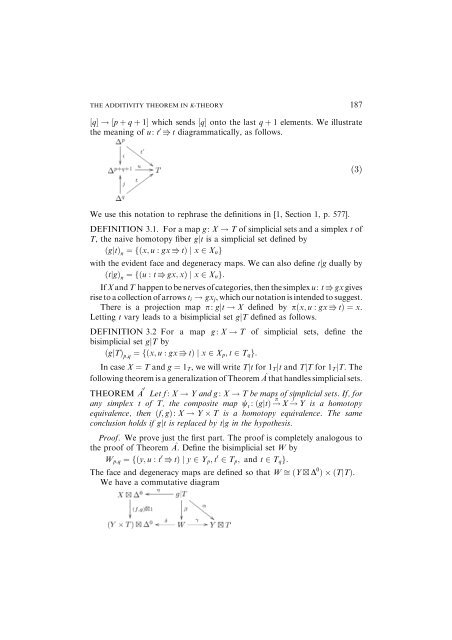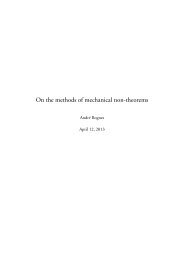The Additivity Theorem in K
The Additivity Theorem in K
The Additivity Theorem in K
You also want an ePaper? Increase the reach of your titles
YUMPU automatically turns print PDFs into web optimized ePapers that Google loves.
THE ADDITIVITY THEOREM IN K-THEORY 187<br />
½qŠ !½p þ q þ 1Š which sends ½qŠ onto the last q þ 1 elements. We illustrate<br />
the mean<strong>in</strong>g of u: t 0 V t diagrammatically, as follows.<br />
We use this notation to rephrase the def<strong>in</strong>itions <strong>in</strong> [1, Section 1, p. 577].<br />
DEFINITION 3.1. For a map g: X ! T of simplicial sets and a simplex t of<br />
T, the naive homotopy fiber gjt is a simplicial set def<strong>in</strong>ed by<br />
ðgjtÞn ¼fðx; u : gx V tÞ jx 2 Xng<br />
with the evident face and degeneracy maps. We can also def<strong>in</strong>e tjg dually by<br />
ðtjgÞn ¼fðu : t V gx; xÞ jx 2 Xng:<br />
If X and T happen to be nerves of categories, then the simplex u: t V gx gives<br />
rise to a collection of arrows ti ! gxj, which our notation is <strong>in</strong>tended to suggest.<br />
<strong>The</strong>re is a projection map p: gjt ! X def<strong>in</strong>ed by pðx; u : gx V tÞ ¼x.<br />
Lett<strong>in</strong>g t vary leads to a bisimplicial set gjT def<strong>in</strong>ed as follows.<br />
DEFINITION 3.2 For a map g: X ! T of simplicial sets, def<strong>in</strong>e the<br />
bisimplicial set gjT by<br />
ðgjTÞp;q ¼fðx; u : gx V tÞ jx 2 Xp; t 2 Tqg:<br />
In case X ¼ T and g ¼ 1T, we will write Tjt for 1Tjt and TjT for 1TjT. <strong>The</strong><br />
follow<strong>in</strong>g theorem is a generalization of <strong>The</strong>orem A^ that handles simplicial sets.<br />
THEOREM A^ 0 Let f: X ! Y and g: X ! T be maps of simplicial sets. If, for<br />
any simplex t of T, the composite map wt : ðgjtÞ! p X ! f Y is a homotopy<br />
equivalence, then ðf; gÞ: X ! Y T is a homotopy equivalence. <strong>The</strong> same<br />
conclusion holds if gjt is replaced by tjg <strong>in</strong> the hypothesis.<br />
Proof. We prove just the first part. <strong>The</strong> proof is completely analogous to<br />
the proof of <strong>The</strong>orem A. ^ Def<strong>in</strong>e the bisimplicial set W by<br />
Wp;q ¼fðy; u : t 0 V tÞ jy 2 Yp; t 0 2 Tp; and t 2 Tqg:<br />
<strong>The</strong> face and degeneracy maps are def<strong>in</strong>ed so that W ffiðY D 0 We have a commutative diagram<br />
Þ ðTjTÞ.<br />
ð3Þ

















